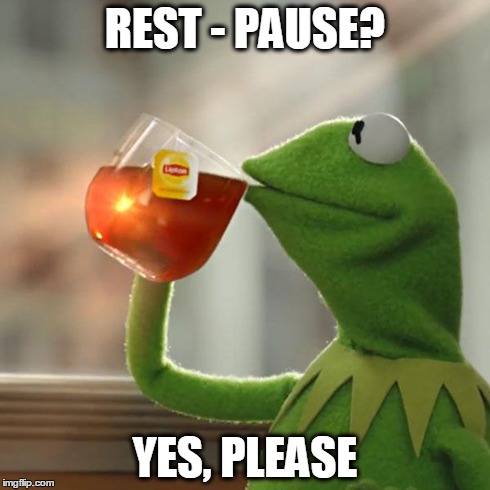A few months back, I started my own little investigation of the most effective training modalities for hypertrophy. But instead of my usual poring over sport science journals, I went about it from a different, more common-sense angle. I decided to develop a list of truly natural bodybuilders and physique athletes (not on roids), then watch how they train on YouTube. What was pretty obvious was that there were commonalities between all of them: 1) they trained with heavy loads generally between 70% and 90% of their one-rep maxes, and 2) their training sessions looked really dense (meaning that they were doing a lot of work in a short time) and intense (meaning that they were creating significant fatigue in the target muscles).
But how were they creating that intensity, that deep, acute fatigue? After watching way too many videos of sweaty, sometimes shirtless men, I found that many of them weren’t strictly adhering to the standard straight sets and reps prescriptions we’re so familiar with, e.g. “four sets of eight reps”, or “five sets of five reps.” Instead, they were oftentimes conducting some form of rest-pause training. You might be familiar with some well-known set strategies like drop sets, giant sets and cluster sets, which I’d classify as species of the genus that is rest-pause. Anyway, a couple of months ago after some experimentation and trial and error, I began rest-pause training in earnest and it’s literally changed my entire approach to lifting.
So what the fug is rest-pause?

It’s just what it sounds like: pausing for a short time between reps or groups of reps and then continuing with more reps. In my definition, rest-pause (RP) refers to a family of lifting methods, each of which can vastly improve the efficiency and effectiveness of any training session. It’s a philosophy that recognizes that no human is a lifting machine and acknowledges the natural variations in performance levels from day to day. At the same time, RP enables a person to lift more total weight in the same period of time with the same, or even less fatigue than would be experienced under a more standard set/ rep routine. RP enables you to lift to your maximum capacity at any given moment in time. RP training is dynamic, flexible, fun, challenging and really, really effective for developing size, which has a direct effect on total strength potential.
My specific take on rest-pause training is that it’s comprised of four distinct methods, which lend themselves well to various types of periodization schemes. They can all be used in the same session, in different sessions in the same week, each for a week or several weeks at a time.
1. Rest-Pause Set Method
Perform a predetermined number of sets and complete as many reps per set as possible just short of form failure.
What this might look like in practice:
Complete as many reps as possible in six sets using 80% of 1-rep max:
7 reps, rest 30 seconds
6 reps, rest 30 seconds
6 reps, rest 30 seconds
5 reps, rest 30 seconds
4 reps, rest 30 seconds
3 reps, stop
How to progress: aim for more reps with the same load in the same number of sets next time, or increase the load by 5% and aim to complete the same number of reps.
A great variation on this is to perform, say, the first three sets with 30-second rests, then rest for 90 seconds, then perform the second set of three sets.
2. Rest-Pause Total Rep Method
Perform a predetermined number of reps without regard for sets. The rep method can be further broken into static rest periods and autoregulated rest periods.
Static rest periods:
Perform as many reps as possible just short of form failure, then rest for a predetermined period of time. Do another set and rest for the same amount of time. Continue until all reps are complete.
Target reps = 50
75% of 1-rep max:
10 reps, rest 20 seconds
9 reps, rest 20 seconds
8 reps, rest 20 seconds
6 reps, rest 20 seconds
5 reps, rest 20 seconds
4 reps, rest 20 seconds
4 reps, rest 20 seconds
4 reps, rest 20 seconds
2 reps, stop
Auto-regulated rest periods:
Perform as many reps as possible just short of form failure and rest until you feel ready to complete more reps. Continue this way until you hit your target reps.
What this might look like in practice:
Target reps = 40
75% of 1 rep max:
10 reps, rest 15 seconds
8 reps, rest 17 seconds
7 reps, rest 20 seconds
5 reps, rest 10 seconds
2 reps, rest 10 seconds
2 reps, rest 18 seconds
3 reps, rest 22 seconds
3 reps
3. Rest-Pause Rep and Set Method
This one comes in a couple of flavors.
The first is the classic cluster set, which I’ve found is exceptionally effective for getting more volume out of very heavy loads with a bias toward strength rather than hypertrophy (equal to or greater than 85% of 1RM) in the same amount of time as straight sets would allow. Like straight sets, each set in a cluster set is comprised of a certain number of reps. But instead of performing, say, five straight reps at a given weight and then resting for two or three minutes before beginning the next set, cluster sets enable more reps to be performed in the same set under the same load by breaking the set up into mini sets with short breaks in between.
What this might look like in practice:
6 cluster sets of 6 reps:
Set 1: 2 reps, rest 10 seconds/ 2 reps, rest 10 seconds/ 2 reps, rest 90 seconds
Set 2: 2 reps, rest 10 seconds/ 2 reps, rest 10 seconds/ 2 reps, rest 90 seconds
etc…
The weight is re-racked for every rest period to allow the muscles to recover some. This is so effective for strength training because unlike hypertrophy-specific training that seeks to fatigue all fibers over the course of several sets, strength training is used to improve the body’s ability to recruit as many muscle fibers as possible at the same time. To train this response, as many fibers as possible need to be kept fresh to improve the potential to activate all of them simultaneously. You end up extracting
The other flavor requires performing a predefined number of reps within a predefined number of sets.
What this might look like in practice:
Complete 50 reps within eight sets.
How to progress: When you can complete 50 reps in less than eight sets, increase the next session’s load. If you can’t complete 50 reps in eight sets, repeat same weight next session.
4. Rest-Pause Time method
Complete as many quality reps as possible in a predefined time period. Rest is autoregulated. Basically rest when you need to.
What this might look like in practice:
10 reps, rest 15 seconds
7 reps, rest 10 seconds
3 reps, rest 10 seconds
2 reps, rest 45 seconds
6 reps, rest 15 seconds
5 reps, rest 60 seconds
6 reps, rest 30 seconds
4 reps, rest 15 seconds
1 rep, rest 10 seconds
1 rep, rest 10 seconds
etc…
How to progress: in the next session, complete more reps with the same load or the same number of reps with 5% more weight.
Some caveats about rest-pause training
Rest-pause is probably best used by intermediate and advanced lifters who clearly understand their bodies, the difference between good and bad form, and the difference between form failure and prime mover failure.
Rest-pause is taxing. Because it increases work density, it’s easy for overtraining to become a problem if specific limits aren’t set. Using rest-pause, my workouts last 45 minutes and I’m out of the gym. As most frequent lifters know, the hardest part isn’t getting to the gym–it’s having the mental resolve to LEAVE the gym and have faith that your body will respond. Even though rest-pause is acutely demanding, just like any other workout, you shouldn’t be dragging and chronically fatigued after completing an RP workout.
Progressive overload is still (and always) critical for making gains. For RP, progressive overload can take on many forms, including decreasing the time in which a given number of reps are performed, increasing the load, or increasing the number of reps performed under the same load. But only one of these forms of overload should be applied to any given lift on any given training session.
In the coming days, I’ll post my current rest-pause routine, which has allowed me to pack on around five pounds of muscle in only two months. I’m now a full 10 lbs heavier than I was in that shot in the sidebar.
